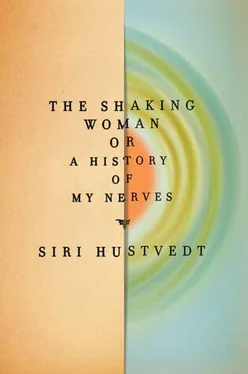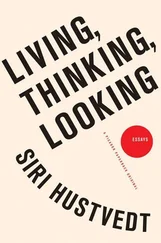They demonstrate that there are neuroanatomical correlates to a hysterical paralysis or blindness — an organic change — but how that happens can’t be discovered from an fMRI; nor do those images tell doctors how to treat their conversion patients. As Sean Spence noted in Advances in Psychiatric Treatment after reviewing brain-imaging studies of conversion symptoms as well as other psychiatric disorders that involve some body problem, including anorexia and auditory hallucinations: “Perhaps the most chastening lesson from this review is the lack of specificity of any of the findings so far described. Although we might predict that a patient describing bodily disturbance of ‘some kind’ will exhibit abnormalities of certain candidate brain regions, we would have great difficulty modifying their diagnosis or treatment on the basis of brain scanning.” 27Nevertheless, the symptoms in conversion are as “real” as any other symptoms, and they may be associated with emotional shocks or traumas.
Justine Etchevery was Charcot’s first hysterical patient. Before she came to the Salpêtrière, her life had been a catalog of miseries. One of fourteen children, she watched most of her siblings die young. She survived both typhoid and cholera. In an institution where she was employed, a man assaulted and tried to rape her. At twenty-five, she had her first convulsive attack, fell into a fire, and was left badly burned and blind in one eye. By the time she arrived at the Salpêtrière, she was suffering from paralysis and a lack of feeling on her left side. Once in the hospital, she had another violent seizure, lost the use of her left arm and, not long after, of all her limbs. The “contractures” lasted eight years. And then, on May 22, 1874, as she was lying in her hospital bed, she had a sudden choking fit, noticed that the stiffness in her right jaw and leg had relaxed, and cried out to the nursing sisters, “I want to get out of bed! I want to walk!” After years of paralysis, Justine climbed out of her bed and walked. 28Hysteria can be the stuff of miracles.
The following is a brief history of another conversion patient described in an appendix to an article in Brain in 2001.
Patient V.U. Forty-year-old right-handed woman who fled from Algeria during childhood, escaping a shooting where relatives were killed. Chronic neck pain with left arm irradiation for several years after car accident with no injury, but no previous somatoform or psychiatry diagnosis. Left arm weakness and numbness 2 months after moving furniture when being forced to move home to Switzerland. She could not raise and maintain left arm outstretched, only slight and slow movements of her fingers. Decreased sensation to light touch on the whole arm without radicular distribution. 29
Although the Brain authors draw an implicit connection between the awful events that had befallen this woman and her illness, they don’t remark on them. Their job was to look at brain scans, where they found subcortical “asymmetries” in all of their seven patients, asymmetries that vanished in the four who recovered. Like Justine, V.U. suffered not one but several traumatic experiences, over which she had no control. The similarity between her childhood “escape” and her “forced” move as an adult cannot be ignored. The original event is mirrored in the later one.
The DSM does not tell stories. It contains no cases of actual patients or even fictional ones. Etiology, the study of the cause of illness, isn’t part of the volume. Its mission is to be purely descriptive, to collect symptoms under headings that will help a physician diagnose patients. There is a companion DSM-IV Casebook, but notably, these narratives about real doctors and patients are gathered in their own volume, separate from the diagnostic tome. The fact is that all patients have stories, and those stories are necessarily part of the meaning of their illnesses. This may be even more true for psychiatric patients, whose stories are often so enmeshed with the sickness that one can’t be untangled from the other.
One day at the hospital I worked with a fifteen-year-old girl. B. was my only student that afternoon, and I told her that I had come to do some writing with her. She said she didn’t want to write. I replied that I never forced anyone to write, and we talked for a while. Then, without warning, she picked up her pencil and poured out a story about two girls. They met in school, liked each other, and began to correspond with each other in notebooks, which they exchanged daily. The secrecy was necessary because both girls had violent, angry fathers and were afraid that they would be overheard if they talked on the phone. In their daily written communications they were able to find some solace, but after a few months, one of the girls’ fathers discovered his daughter’s notebook, and only days later, he left town with her. The girl who remained never saw her friend again. I praised the story and said that it was terribly sad. That was when my student looked up and said, “It’s my story.” Then she paused, looked me in the eyes, and added, “You see, I was beaten by my father and raped by my brother. That’s why things are so hard for me.” It was difficult to answer her. When I left the hospital that day, I asked myself if it was possible to distinguish between her illness and the story she had told me of violence and rape. Wasn’t that narrative part of the sickness itself? Can the two be separated?
Désiré-Magloire Bourneville was a young alienist who worked with Charcot and wrote detailed clinical accounts of hysterical patients at the Salpêtrière. “In their delirium,” he wrote, “hysterics have remembrances [ réminiscences ] of long ago events in their lives, physical pains as well as psychological feelings [ des émotions morales ], events which have set off their attacks in the past… nothing is more sure than that they remember these emotional events.” 30Later, Freud and Breuer would write these far more famous words: “Hysterics suffer mainly from reminiscences.” 31The girl in the hospital wasn’t a conversion patient. I don’t know what her diagnosis was, but she was obviously traumatized by her memories of having been hurt and violated. True stories can’t be told forward, only backward. We invent them from the vantage point of an ever-changing present and tell ourselves how they unfolded. Why one person who has been badly treated by a parent turns into a psychopath and another with similar treatment suffers from severe depression and yet another develops an inexplicable paralysis isn’t clear. What is clear is that memory is essential to who we are, and memories can be both implicit and explicit — unconscious and conscious. Freud wasn’t the first to argue that most of what the brain does is unconscious. The nineteenth-century English physiologist William Carpenter, the German psychologist Gustav Fechner, and the German physicist Hermann von Helmholtz all maintained that there was a psychological unconscious, not just a physiological one. Thoughts, memories, and ideas could reside outside of our awareness. Freud tried to understand how unconscious processes in the psyche work.
No neuroscientist now disputes the existence of an unconscious. But it’s strange to think that not long ago, the very idea was regarded with suspicion. After my bout in Mount Sinai Hospital I was sent to a psychologist, Dr. E., who taught me biofeedback. I was hooked up to a machine with electrodes, and over a period of eight months I learned how to relax, how to increase my blood circulation, warm my extremities, and reduce my pain. Dr. E. was a behaviorist. I vividly remember him saying: “If there is an unconscious, who cares?” Behaviorism closed the door on the unconscious because its advocates asserted that everything that needed to be understood about human beings could be deduced from looking at their behavior — a third-person view. The murky regions of the first person presented a trap. And yet illness, any illness, is always experienced by someone . There is a phenomenology of being sick, one that depends on temperament, personal history, and the culture in which we live.
Читать дальше












